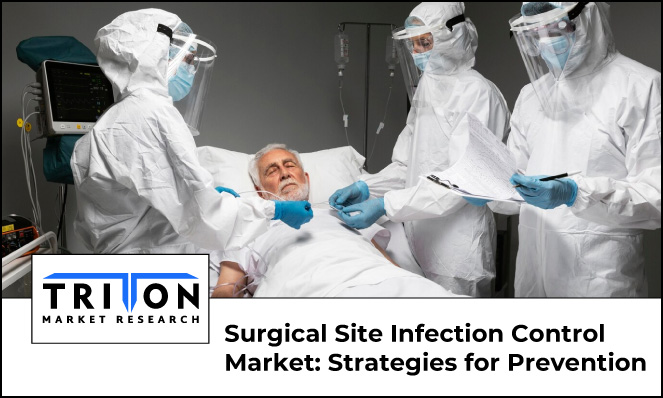



30, October 2024

SSIs occur at the incision site or deeper tissue post-surgery and can result in extended hospital stays, increased morbidity, and, in severe cases, fatality. The European Centre for Disease Prevention and Control (ECDC) reports that the incidence of surgical site infections (SSIs) varies by procedure, ranging from 0.6% in knee prosthesis surgeries to as high as 9.5% in open colon surgeries. Hence, healthcare providers and institutions are focusing on elevating patient safety and controlling SSIs. In this regard, our research suggests that the Global Surgical Site Infection Control Market is expected to advance with a CAGR of 5.21% over the forecast period 2024-2032. Let us understand why controlling SSIs is a crucial aspect of providing qualitative patient care.
According to the WHO, proper hand hygiene and affordable, preventive measures can help prevent up to 70% of infections. Thus, the healthcare industry implements numerous strategies to reduce the risk of SSIs, starting from preoperative to postoperative care. These include:
Preoperative Measures: Patient screening for existing infections, administration of prophylactic antibiotics, and skin antisepsis with alcohol-based solutions.
Intraoperative Techniques: Maintaining a sterile environment in the operating room is paramount. This includes sterilizing instruments, using sterile gloves, gowns, and surgical drapes, and ensuring that surgical teams follow strict hygiene protocols.
Postoperative Care: Monitoring wounds closely for signs of infection, maintaining proper wound dressings, and educating patients on wound care post-discharge are crucial steps in reducing the risk of SSIs.
Explore in detail about this market in our FREE sample
SSIs are categorized into three main types based on the depth and location of the infection. Superficial Incisional SSI affects only the skin or subcutaneous tissue around the incision site. It is the least severe form but still requires careful management. Similarly, deep incisional SSI may penetrate deeper into the tissues beneath the incision, such as muscles or surrounding structures. These can be more painful and take longer to heal.
Another severe type of infection is the organ/space SSI, which can occur in any part of the body, such as organs or spaces that were opened or manipulated during surgery. It can also lead to significant complications and may require additional surgery to manage.
Medical consumables play a vital role in preventing surgical site infections. From preoperative antiseptics to postoperative wound care products, consumables are indispensable tools in infection control. In fact, advanced sterilization and disposable products are designed to reduce the overall bacterial load in the operating room, thus lowering the risk of postoperative infections.
Consumables like antimicrobial dressings are designed with infection-prevention technologies that actively fight off bacteria that could enter through the surgical site. Similarly, antimicrobial sutures provide an additional barrier to bacteria that could lead to SSIs, helping to minimize the risk during the critical healing period.
In many cases, comprehensive wound care kits are also provided post-surgery to help patients manage their wounds at home, ensuring proper hygiene and dressing changes to mitigate the risk of infection. During the surgical process, high-quality, sterile disposable drapes and gowns are also utilized to ensure that no contaminants from the surrounding environment or surgical team reach the incision site.
Connect with our experts for a simplified analysis!
Maintaining optimal environmental conditions during surgeries reduces the chances of contamination from both the environment and the medical staff. Cleanrooms are designed to control contamination levels, regulate environmental factors like air filtration, and ensure a sterile environment—principles that directly impact infection control in surgical settings.
Cleanroom technology use high-efficiency particulate air (HEPA) filters to remove airborne contaminants, including bacteria and particles that could lead to infections. In surgical rooms, ensuring clean air reduces the risk of airborne pathogens settling on open surgical wounds or sterile instruments, thereby lowering the potential for SSIs.
A study published in the American Journal of Infection Control (Feb 2024) investigated the impact of HEPA and ultraviolet air recirculation systems (HUAIRS) on surgical site infection rates at an orthopedic specialty hospital. These systems were installed in all operating rooms, and SSI rates for nervous system procedures were compared over 2.5-year periods before and after their implementation. The results showed a dramatic drop in SSIs, from 2.06% before HUAIRS to just 0.29% afterward.
While cleanrooms are typically associated with manufacturing or pharmaceutical labs, many modern hospitals employ cleanroom technology principles. In fact, hospitals looking to reduce SSIs may adopt cleanroom-inspired technologies, especially in high-risk surgical procedures or sensitive environments like transplant surgeries, where infection control is critical. This could lead to an effective reduction in infection rates, as the controlled environment limits potential bacterial contamination during operations.
In conclusion, surgical site infections are a significant concern in healthcare, but with strict protocols, advanced consumables, and the integration of cleanroom technologies, their occurrence can be minimized. Continuous innovation in infection control practices ensures improved patient safety, faster recovery times, and enhanced overall surgical outcomes.
Grab a Quick Read to Get a Comprehensive Analysis of this Market
Answer: Surgeons may debride the wound by removing dead or infected tissue, rinse with saline, drain any abscess, and pack with saline-soaked dressings before covering it with a bandage.
Q.2: Which surgeries have the highest risk of infection?Answer: Colorectal surgery was reported to have the highest SSI rate (9.43%), followed by pilonidal sinus (8.79%), upper GI (8.09%), hepatobiliary (6.68%), hernia (0.78%), and breast-thyroid surgery (0.3%).

Prevalent cases of terrorist attacks in today’s world is increasing the need for severe standards of security for public safety, and the global market for biometric technology scrupulously accommoda..
Prevalent cases of terrorist attacks in today’s world is increasing the need for..